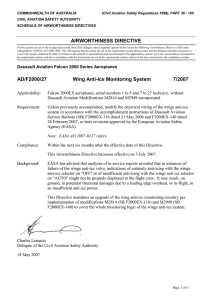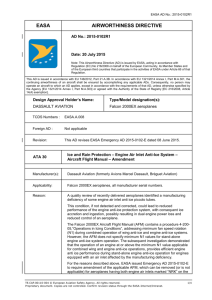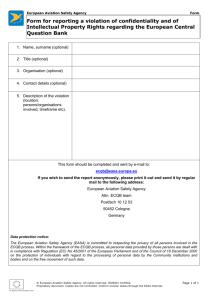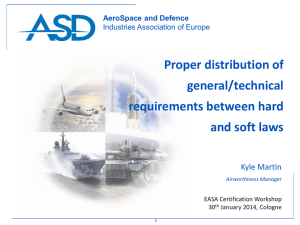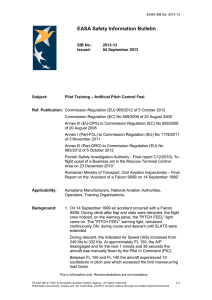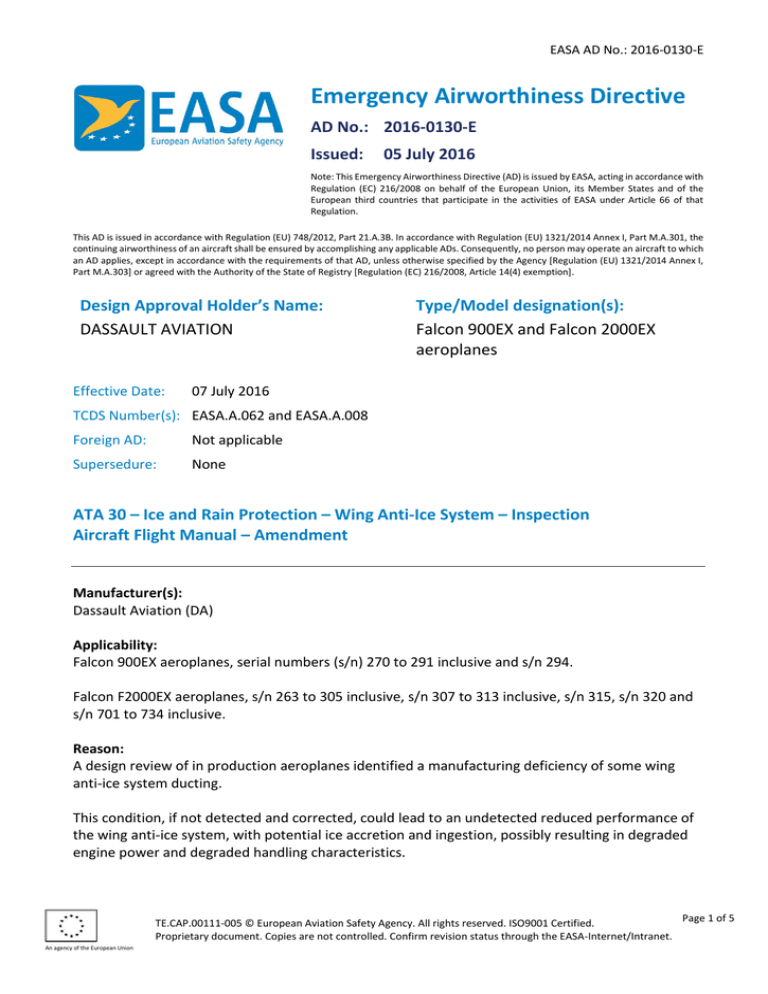
EASA AD No.: 2016-0130-E
Emergency Airworthiness Directive
AD No.: 2016-0130-E
Issued:
05 July 2016
Note: This Emergency Airworthiness Directive (AD) is issued by EASA, acting in accordance with
Regulation (EC) 216/2008 on behalf of the European Union, its Member States and of the
European third countries that participate in the activities of EASA under Article 66 of that
Regulation.
This AD is issued in accordance with Regulation (EU) 748/2012, Part 21.A.3B. In accordance with Regulation (EU) 1321/2014 Annex I, Part M.A.301, the
continuing airworthiness of an aircraft shall be ensured by accomplishing any applicable ADs. Consequently, no person may operate an aircraft to which
an AD applies, except in accordance with the requirements of that AD, unless otherwise specified by the Agency [Regulation (EU) 1321/2014 Annex I,
Part M.A.303] or agreed with the Authority of the State of Registry [Regulation (EC) 216/2008, Article 14(4) exemption].
Design Approval Holder’s Name:
DASSAULT AVIATION
Effective Date:
Type/Model designation(s):
Falcon 900EX and Falcon 2000EX
aeroplanes
07 July 2016
TCDS Number(s): EASA.A.062 and EASA.A.008
Foreign AD:
Not applicable
Supersedure:
None
ATA 30 – Ice and Rain Protection – Wing Anti-Ice System – Inspection
Aircraft Flight Manual – Amendment
Manufacturer(s):
Dassault Aviation (DA)
Applicability:
Falcon 900EX aeroplanes, serial numbers (s/n) 270 to 291 inclusive and s/n 294.
Falcon F2000EX aeroplanes, s/n 263 to 305 inclusive, s/n 307 to 313 inclusive, s/n 315, s/n 320 and
s/n 701 to 734 inclusive.
Reason:
A design review of in production aeroplanes identified a manufacturing deficiency of some wing
anti-ice system ducting.
This condition, if not detected and corrected, could lead to an undetected reduced performance of
the wing anti-ice system, with potential ice accretion and ingestion, possibly resulting in degraded
engine power and degraded handling characteristics.
Page 1 of 5
TE.CAP.00111-005 © European Aviation Safety Agency. All rights reserved. ISO9001 Certified.
Proprietary document. Copies are not controlled. Confirm revision status through the EASA-Internet/Intranet.
An agency of the European Union
EASA AD No.: 2016-0130-E
The Falcon 900EX EASY and Falcon 200EX Aircraft Flight Manuals (AFM) contain a normal procedure
4-200-05A, “Operations in Icing Conditions”, addressing minimum fan speed rotation (N1) during
combined operation of wing anti-ice and engine anti-ice systems. The subsequent investigation
demonstrated that the wing anti-ice system performance for aeroplanes equipped with ducting
affected by the manufacturing deficiency can be restored increasing N1 value. In addition, Dassault
Aviation published Service Bulletin (SB) F900EX-464 (for Falcon 900EX aeroplanes) and
SB F2000EX-393 (for Falcon 2000EX aeroplanes), providing instructions for wing anti-ice system
ducting inspection.
For the reasons described above, this AD requires an AFM amendment and a one-time inspection of
the wing anti-ice system ducting and, depending on findings, re-identification or replacement of the
wing anti-ice system ducting.
Required Action(s) and Compliance Time(s):
Required as indicated, unless accomplished previously:
(1) For aeroplanes in pre-SB F900EX-464 or pre-SB F2000EX-393 configuration, as applicable, within
10 Flight Cycles (FC) after the effective date of this AD, amend the applicable AFM as specified
in Appendix 1 or Appendix 2 of this AD, as applicable to aeroplane type, inform the flight crew
and, thereafter, operate the aeroplane accordingly. Amending the AFM can be accomplished by
inserting a copy of Appendix 1 or Appendix 2 of this AD, as applicable to aeroplane type, into
the applicable AFM.
(2) Within 9 months after the effective date of this AD, inspect the wing anti-ice system ducting
and, depending on findings, re-identify or replace the wing anti-ice system ducting in
accordance with the instructions of Dassault Aviation SB F900EX-464 or SB F2000EX-393, as
applicable to aeroplane type.
(3) After accomplishment of the actions as required by paragraph (2) of this AD on an aeroplane,
the AFM amendment, as required by paragraph (1) of this AD, can be removed from the
applicable AFM of that aeroplane.
Ref. Publications:
Dassault Aviation SB F900EX-464, original issue dated 20 June 2016.
Dassault Aviation SB F2000EX-393, original issue dated 05 June 2016.
The use of later approved revisions of these documents is acceptable for compliance with the
requirements of this AD.
Remarks:
1. If requested and appropriately substantiated, EASA can approve Alternative Methods of
Compliance for this AD.
2.
The results of the safety assessment have indicated the need for immediate publication and
notification, without the full consultation process.
Page 2 of 5
TE.CAP.00111-005 © European Aviation Safety Agency. All rights reserved. ISO9001 Certified.
Proprietary document. Copies are not controlled. Confirm revision status through the EASA-Internet/Intranet.
An agency of the European Union
EASA AD No.: 2016-0130-E
3.
Enquiries regarding this AD should be referred to the EASA Safety Information Section,
Certification Directorate. E-mail: ADs@easa.europa.eu.
3.
For any question concerning the technical content of the requirements in this AD, please
contact your Dassault Falcon Technical Assistance:
For Europe, Middle East and Africa based operators: Hot Line: (33) 1 47 11 37 37
For USA, Canada and Mexico based operators: Help Desk: (1) 800-2FALCON (2325266)
For all other areas: Help Desk: (1) 201 541 4747.
Page 3 of 5
TE.CAP.00111-005 © European Aviation Safety Agency. All rights reserved. ISO9001 Certified.
Proprietary document. Copies are not controlled. Confirm revision status through the EASA-Internet/Intranet.
An agency of the European Union
EASA AD No.: 2016-0130-E
F900EX - Appendix 1 to EASA AD No.: 2016-0130-E
Amendment to AFM section 4-200-05A OPERATION IN ICING CONDITIONS
This amendment comes in addition to existing AFM procedures
Wings Anti Ice System Operation
During in flight operation of a wings anti-ice system (WINGS ANTI-ICE) maintain the N1 of all engines
equal to or more then the values defined in Table 1 of this Appendix, as applicable to atmospheric
condition.
Table 1
New Minimum N1 values required during in flight operation of a wings anti-ice system
Three operative engines:
TAT
– 30 to – 20 to – 10 to
0 to
– 20 °C – 10 °C
0 °C
+ 10 °C
Above 20,000 ft
79 %
75 %
71 %
66 %
From 20,000 ft to 10,000 ft
76 %
73 %
66 %
59 %
Below 10,000 ft
68 %
66 %
61 %
58 %
These new values include 3% increase compared to former values (4-200-05A page 1/2).
Two operative engines:
TAT
– 30 to
– 20 to
– 10 to
0 to
– 20 °C – 10 °C
0 °C
+ 10 °C
Above 20,000 ft
86 %
82 %
78 %
73 %
From 20,000 ft to 10,000 ft
83 %
80 %
73 %
66 %
Below 10,000 ft
75 %
73 %
68 %
65 %
These new values include 3% increase compared to former values (4-200-05A page 1/2).
TAT – Total Air Temperature
Note 1: Maintaining the N1 above the minimum anti-ice N1 on all engines may lead to exceedance
of approach speed. Early approach or landing configuration of an aeroplane and/or application of
airbrakes may be used to control the airspeed. In approach and landing and for a limited duration up
to three minutes, selection of N1 speeds below the minimum anti-ice N1 speed is authorized. In this
case it is necessary to disengage the autothrottle.
Effectivity: F900EX (LX variant) S/N 270 to 291, 294 without Dassault Aviation SB F900EX-464
Page 4 of 5
TE.CAP.00111-005 © European Aviation Safety Agency. All rights reserved. ISO9001 Certified.
Proprietary document. Copies are not controlled. Confirm revision status through the EASA-Internet/Intranet.
An agency of the European Union
EASA AD No.: 2016-0130-E
F2000EX - Appendix 2 to EASA AD No.: 2016-0130-E
Amendment to AFM section 4-200-05A OPERATION IN ICING CONDITIONS
This amendment comes in addition to existing AFM procedures
Wing Anti Ice System Operation
During in flight operation of a wing anti-ice system (WING ANTI-ICE) maintain the N1 of both engines
equal to or more then the values defined in Table 1 of this Appendix, as applicable to atmospheric
condition.
Table 1
New Minimum N1 values required during in flight operation of a wing anti-ice system
Two engines operative minimum N1:
TAT
Z
-30 °C
-15 °C
0 °C
+10 °C
31,000 ft
74.6
67.6
52.8
52.8
22,000 ft
72.4
63.7
52.8
52.1
3,000 ft
57.3
54.9
49.4
48.8
0 ft
54.9
54.9
49.4
48.8
These new values include 2% increase compared to former values (4-200-05A page 1/2).
Z
One engine operative or one bleed inoperative minimum N1:
TAT
-30 °C
-15 °C
0 °C
+10 °C
31,000 ft
82.4
77.0
64.0
58.0
22,000 ft
79.2
72.0
59.8
56.6
3,000 ft
71.2
66.4
59.8
49.3
0 ft
64.2
63.7
59.8
49.3
These new values include 2% increase compared to former values (4-200-05A page 1/2).
TAT – Total Air Temperature
Z – Altitude
Note 1: Maintaining the N1 above the minimum anti-ice N1 on all engines may lead to exceedance of
approach speed. Early approach or landing configuration of an aeroplane and/or application of
airbrakes may be used to control the airspeed. In approach and landing and for a limited duration up
to three minutes, selection of N1 speeds below the minimum anti-ice N1 speed is authorized. In this
case it is necessary to disengage the autothrottle.
Effectivity: F2000EX (LXS/S variants) S/N 263 to 305,307 to 313, 315, 320, 701 to 734 without
Dassault Aviation SB F2000EX-393
Page 5 of 5
TE.CAP.00111-005 © European Aviation Safety Agency. All rights reserved. ISO9001 Certified.
Proprietary document. Copies are not controlled. Confirm revision status through the EASA-Internet/Intranet.
An agency of the European Union

